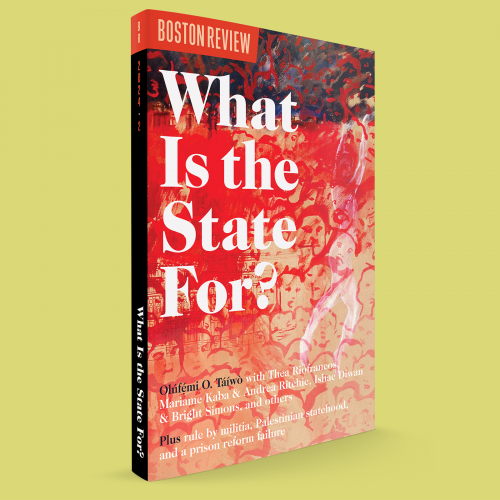Táíwò asserts that the essential fight of our lives is that against fossil capital, and he argues for aligning the state’s interests against the organized interests of oil, gas, and coal producers as our necessary first step to transform the world.
Fossil capital has an accomplice: real estate capital. “Real estate capital” refers to investments in residential and commercial properties and related trusts. Today the level of real estate capital flowing through investment trusts and across oceans has reached a historic scale. The landlord-tenant contradiction, the inherent conflict of interests between tenants and the individuals or institutions that own their homes, is high-pitched and painful. The rent is too damn high. Most tenants don’t know their landlords, who are shielded by registered agents and property managers, setting rents by algorithm from thousands of miles away to maximize profits. The state is in business with our slumlords, financing their investments through favorable loan terms, responsive to the whims of a hefty industry lobby that does not discriminate along party lines. And the state deploys eviction, a violent tool of its own invention, to protect capital’s interests over public needs.
Much of this resembles Táíwò’s characterization of fossil capital—brutal, all-encompassing—and it is no coincidence. Today, fossil capital and real estate capital enjoy an interconnected capture of the world economy and the state. The consolidation of the rental and utility markets create monopolistic patterns that trap people in price-gouging schemes and prevent decarbonization. At the political level, utility companies whose business models rely on fossil capital work in alliance with real estate lobbyists to block tenant protections and decarbonization regulations.
This joint capture comes with catastrophic costs. The climate crisis is the biggest displacement threat worldwide, and those displaced by climate events struggle to find housing in the communities where they land. Real estate development—involving construction machinery, transportation of materials, air conditioning, and heating systems—relies on fossil fuels, serving as an accelerant to the climate crisis. The roughly 140 million housing units in the United States cause over 15 percent of the country’s greenhouse gas emissions, more than all commercial buildings combined. Over a third of U.S. households can’t afford their monthly utility bills, a burden felt disproportionately by nonwhite tenants. Utility shutoffs are a leading cause of homelessness. As Daniel Aldana Cohen wrote in 2019, “In the real world, you can’t separate the carbon causing the climate emergency from our physical and economic systems, any more than you can separate windows, furnaces, and air conditioners from your monthly rent bill.”
When we imagine what it would take to contend against all this, it is difficult to avoid despair. But that which evokes this despair may also offer a way out. If it is true that fossil capital and real estate capital exist in a mutually supporting relationship, it should also be true that our strategies to combat them are connected, and maybe even more deeply than we have considered before.
As we conceive of the small and giant steps toward dethroning fossil (and real estate) capital, we should consider the tenant. The tenant, often also a worker, is a rarely acknowledged character in the struggle against global racial capitalism. Fossil capital—while materially impacting our lives in major ways, all the time—can feel abstracted from day-to-day life. What feels present? The abuses of real estate capital: the broken heater, the gas bill, the mold on the wall, the leaky windows, the rent. Tenants, especially poor and working-class tenants, exist at the intersection of two interlinked crises: they are the most vulnerable to climate emergencies, and they live the daily emergency of powerlessness relative to their landlords.
The union offers a fighting chance. “We deserve better, and we should want more. But it’s the getting more, not the wanting, that is the problem,” writes Táíwò. The getting more, the transforming the world—these ends require organizing. Not slogans, not coalitions, not email lists. Organizing. People must be politicized around their own experience, join organizations, finesse skills, make collective decisions, take action with their neighbors, evaluate those actions, and act again. This is the work of a union, whether in the context of the workplace or in the context of our homes. Tactic is what we do, strategy is why we do it; the union sharpens both. The union becomes a venue for rigorous questioning, experimentation, and refinement.
Tenant unions are among the most promising of such venues. Classically, tenant unions operate within a building, where neighbors come together to improve conditions or negotiate with landlords. But the struggle against contemporary real estate capital, in all its twisted glory, can’t be solely fought building by building. Some tenant unions—like those in Kansas City and Louisville—organize across neighborhoods and citywide; others, as in Connecticut and North Carolina, are organizing statewide.
The truth is, there is not yet a consistent practice of tenant organizing that meets the needs of our moment. But unions, like those named here, are working to change that, uniting across geography and aligning methodology to manifest their fullest potential. We tenant unionists, committed to the home as a necessary site of struggle, think of ourselves as in a similar place now to where organized labor was in the early part of the twentieth century, before mass organization and formal bargaining processes, before big money and millions of members: in a sweet but urgent spot to define what the union can be, learning from past formations and responding to our current conditions.
The scale of our twinned crises rightly fixates most of us on the state as the necessary large-scale agent for intervention. From this perspective, tenant unions and most nonstate players might be considered too small, too local, to force the state’s hand or to impact fossil capital directly. But this view is anti-visionary. The grasp of fossil capital requires adversaries that will not just pose the question of how to untangle the state from capital interests, but force it to happen. Who can wield enough power to do so? Tenant unions are among the options with the most unexplored possibility. Both in their traditional form (within single buildings) and in new arrangements, tenant unions are picking bigger fights, applying more sophisticated target analysis, and creating alternatives to the existing housing market. In these moves, they can plot the course for the “delinking” Táíwò urges.
The question of the precise path forward—within the state, in relationship to the state, outside of the state, in stages—is one that can only be answered on the ground, in a union. Whatever the strategy, strategies require people to explore them; practice begets theory, not the other way around. The small step, toward the giant steps, toward transforming the world, involves trying what we haven’t tried before. What if tenants can organize at scale, wielding a new kind of power in relation to their homes? What if they can do so alongside farmworkers, ratepayers, trade unionists? Could that be a winning team to take on fossil capital, real estate capital, and all that hurts us? We have to try.
Independent and nonprofit, Boston Review relies on reader funding. To support work like this, please donate here.









